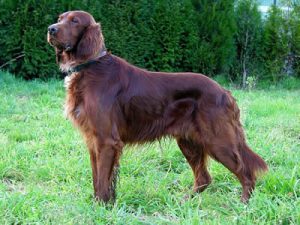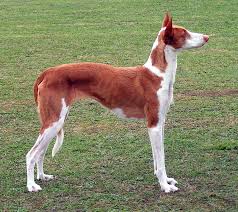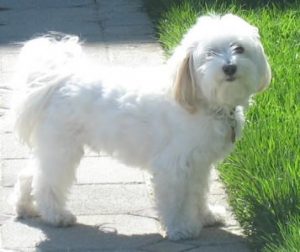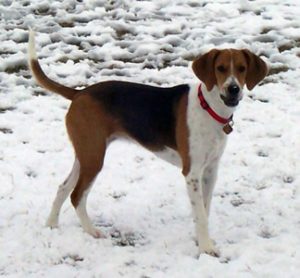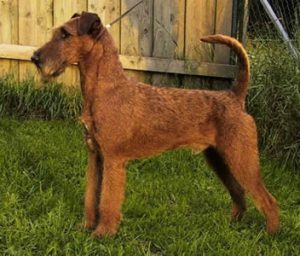
The Irish Terrier is a dog breed from Ireland, one of many breeds of Terrier.
The Irish Terrier is an active and compactly sized dog that is suited for life in both rural and city environments. Its harsh red coat protects it from all kinds of weather.
Appearance
Breed standards describe the ideal Irish Terrier as being racy, red and rectangular. Racy: an Irish Terrier should appear powerful without being sturdy or heavy. Rectangular: the outline of the Irish Terrier differs markedly from those of other terriers. The Irish Terrier’s body is proportionately longer than that of the Fox Terrier, with a tendency toward racy lines but with no lack of substance.
The tail is customarily docked soon after birth to approximately two-thirds of the original length. In countries where docking is prohibited, the conformation judges emphasise tail carriage. The tail should start up quite high, but it should not stick straight up or curl over the back or either side. The ears are small and folded forward just above skull level. They are preferably slightly darker than the rest of the coat. It is fairly common to see wrongly positioned ears, even though most dogs have their ears trained during adolescence.
Coat and colour
The Irish Terrier is coloured golden red, red wheaten, or wheaten. Dark red is often mistaken as the only correct colour, possibly because wheaten coats are often of worse quality. As with many other solid-coloured breeds, a small patch of white is allowed on the chest. No white should appear elsewhere. As an Irish Terrier grows older, grey hair may appear here and there.
The outer part of the double coat should be straight and wiry in texture, never soft, silky, curly, wavy, or woolly as might be expected in the Kerry Blue Terrier. The coat should lie flat against the skin, and, though having some length, should never be so long as to hide the true shape of the dog. There are longer hairs on the legs, but never so much as a Wire Fox Terrier or Schnauzer. That means you have to have the coat trimmed often which can be expensive.
The inner part of the coat, called the under-wool or undercoat, should also be red. The under-wool may be hard for the inexperienced eye to see. Coat should be quite dense and so that “when parted with the fingers the skin is hardly visible”.
A properly trimmed Irish Terrier should have some “furnishings” on legs and head. The slightly longer hair on the front legs should form even pillars, while the rear legs should only have some longer hair and not be trimmed too close to the skin. The chin is accentuated with a small beard. The beard should not be as profuse as that of a Schnauzer.
The eyes should be dark brown and quite small with a “fiery” expression. The eyes are topped with well-groomed eyebrows. The whole head should have good pigmentation.
Size
Most countries have breed descriptions that say that the Irish Terrier should not be more than 48 cm measured at the withers. However, it is not unusual to see bitches that are 50 cm tall or dogs that are even 53 cm (20 in). Younger generations are closer to the ideal, but there is a downside to this: when an Irish Terrier is very small and light-boned, it loses the correct racy type.
Very seldom does one see Irish Terriers that weigh only 11 to 12 kg (25-27 lb), as the original Kennel Club breed description states. 13 kg for a bitch and 15 for a dog are acceptable.
Temperament
The Irish Terrier is full of life, but not hyperactive. It should be able to relax inside the house and be roused to full activity level quickly.
Irish Terriers are good with people. Most Irish Terriers love children and tolerate rough-housing to a certain extent. Choosing the Irish Terrier as a first dog may be very hard work and not the best choice for a first dog especially if you will not be there with it for most of the day because they are very energetic dogs. They should know who is the boss, and have natural respect for him/her. Irish Terriers respond best to firm, consistent training from a relaxed, authoritative person. Violence should never be used – it is always best to outwit and lure.
Irish Terriers are often dominant with other dogs, particularly same-sex aggression is a common problem. The Irish Terrier will commonly be attracted to species of the same-sex. Poorly socialised individuals will start fights with minimal, if any, provocation. Thus, early socialisation is a necessity. Most can have strong guarding instincts and when these instincts are controlled, make excellent alarming watchdogs, but if they are not controlled, your dog will be very aggressive and not very compassionate towards the owner.
Irish Terriers are intelligent but it takes time for them to learn new things. They can learn tasks with some ease, when they have the motivation to do so. In motivating tidbits and toys work equally well. Training will not be as easy as with other dog breeds that have stronger willingness to please people. When seeking a trainer, one should look for a person who has experience with terriers.
The Irish Terrier is an active dog, and loves to be challenged mentally and physically when motivated. Most Irish Terriers are show dogs. There are however more and more people joining organised dog sports with their ITs. Obedience training to a certain level is fairly easy, though the precision and long-lasting drive needed in the higher levels may be hard to achieve. Many Irish Terriers excel in agility, even though it may be hard to balance the speed, independence and precision needed in the higher levels. To date there is one Agility Champion in the US, and a handful of Finnish and Swedish Irish terriers compete at the most difficult classes.
Irish Terriers have a good nose and can learn to track either animal blood or human scent. Many Irish Terriers enjoy Lure Coursing, although they are not eligible for competition like sight hounds are. In Finland one Irish Terrier is a qualified Rescue Dog specialising at Sea Rescue.
—————————————————————————————————————–
CARING FOR YOUR DOG NEWSLETTER – Delivered Directly To Your Inbox – Starting Immediately – SIGN UP FOR FREE TODAY
—————————————————————————————————————–

